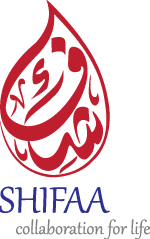Blood donation database
Blood donation database
Shifaa operates a database of potential blood donors. Shifaa acts as a liaison between the person in need of blood and the donor.
The person in need of blood contacts us to inform us of the specific blood type required. We, in turn, communicate with eligible donors from our database to see who is able to go and donate blood. A follow-up is then made with the patient’s family accordingly, in order to inform them about the availability of the donor.
Donation Process
The procedure for donating blood follows these simple steps:
Registration:
- When you arrive to the blood donation site, a nurse will go over basic eligibility requirements and donation information.
- You will be asked to sign a consent form stating that you have been provided with all necessary information, and granted the chance to ask questions.
Health screening
- You will be asked questions about your health history during a private and confidential interview.
- Before giving blood, a nurse will check your pulse, temperature and blood pressure. A blood sample will be extracted from your finger for analysis to make sure your blood iron levels are sufficient to proceed with the donation.
The process
- During the 10-minute donation process, you will be comfortably seated in a reclined position.
- A nurse will cleanse an area on your arm using an antiseptic and insert a sterile needle in the vein to draw blood. The needle will be attached to a plastic tube leading to a sterile bag retaining the blood. The donation kit will be used only once and will then be disposed of.
- Once completed, the nurse will place a bandage on your arm and then accompany you to a resting area and offer you refreshments.
- During the donation process, one unit of blood will be extracted. It will then be immediately sent to the laboratory for analysis and storage.
- During platelet donation, a small portion of blood is drawn and passed through a special, cell-separating machine. All but the needed blood components are returned to the donor.
- Donating platelets is a lengthier process and could take up to 2 hours, but it is beneficial to many patients. One process could help up to 3 adults, or 12 children, which makes it completely worth it.
Facts about Blood & its components
In a medical treatment, patients may receive whole blood or just specific components of the blood needed to treat their particular medical condition. In the following section, we will briefly introduce the main blood components that can be transfused from one person to another:
- Whole Blood
Whole blood is ‘human blood’ received through a standard blood donation, from which other components derive. It contains red cells, white cells (<1%), and platelets all covering approximately 45% of volume, suspended in plasma in the remaining 55%.
- Red Cells
Red cells, or otherwise known as erythrocytes, carry oxygen from the lungs when you inhale, and take carbon dioxide to your lungs when you exhale.Since red blood cells are the most common in blood transfusions, they are the most useful when it comes for example to accident victims who have lost a great deal of blood, patients with bleeding ulcers, patients undergoing critical surgeries, or patients with severe anemia, and more.
- Platelets
Platelets, or otherwise known as thrombocytes, are small, colorless cell fragments in the blood, with a vital function: to interact with clotting proteins to control the bleeding when it occurs. When platelets are activated, they adhere to each other to stop the blood flow in damaged blood vessels.Platelets could also be beneficiary to cancer patients going through chemotherapy and patients undergoing transplant surgeries.
- Plasma
Plasma is a fluid, composed of about 92% water (therefore constituting 55% of the body’s total blood volume), 7% vital proteins such as albumin, gamma globulin, anti-hemophilic factor, and other clotting factors, and 1% mineral salts, sugars, fats, hormones and vitamins. Plasma could also be used for many medical cases including (but not limited to) clotting problems, burn victims and liver disease.
- Cryoprecipitate AHF
Cryoprecipitate Antihemophilic Factor (Cryo) is a frozen blood product prepared from the plasma. It is prepared by freezing and then, slowly thawing the frozen plasma. It is rich in clotting factors, such as Factor VIII (an essential blood-clotting protein), Fibrinogen (an essential blood-clotting protein), Factor XIII (an enzyme of the blood coagulation system), and Von Willebrand Factor (a blood glycoprotein). Indications for giving Cryo include Hemophilia, massive hemorrhage, or excessive bleeding.
